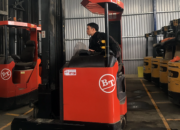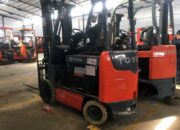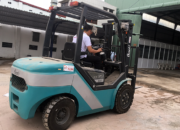-
 The Most Reputable Forklift Brands Today
The Most Reputable Forklift Brands TodayThe Most Reputable Forklift Brands Today Forklifts are essential equipment in industries, logistics, and warehousing. Choosing a reputable forklift brand not only ensures operational efficiency but also optimizes costs and enhances safety. In this article, we introduce the top 5 most trusted forklift brands today—Toyota, Linde, Kalmar, Komatsu, and Cat—along with their strengths and standout […]
-
 FAQs about Forklift Battery and Electrical System
FAQs about Forklift Battery and Electrical SystemFAQs about Forklift Battery and Electrical System 1. What is the average lifespan of a forklift battery? The average lifespan of a forklift battery is typically between 4-6 years for lead-acid batteries, depending on usage, working conditions, and maintenance. Gel batteries have a shorter lifespan, around 3-5 years. 2. How should I maintain my forklift battery? To maintain your forklift battery, you should regularly check and top up the water level, clean the charging terminals and battery poles, ensure full charging without overcharging, regularly check electrolyte density and cell voltage. 3. How can I maximize the lifespan of my forklift battery? To maximize the lifespan of your forklift battery, you should use the correct capacity battery, follow proper installation procedures, maintain full charging, avoid deep discharging, perform regular maintenance, adjust electrolyte density as needed, and keep it clean. 4. What factors affect the lifespan of a forklift battery? The main factors that affect the lifespan of a forklift battery include initial battery quality, using the correct capacity battery, charging and discharging methods, operating temperature conditions, maintenance and storage practices, and working conditions (vibration, humidity, dust). 5. When should I replace my forklift battery? Typically, you should replace your forklift battery after 4-6 years of use depending on the quality of the battery, usage level, and maintenance conditions. If the battery experiences severe performance degradation before that time frame, it should be replaced earlier. Monitoring electrolyte density can help evaluate remaining battery life. 6. When and how should I charge my forklift battery? You should charge your forklift battery after each work shift. The best method is to use an automatic three-stage controlled charger (bulk-float-equal) with periodic water replenishment for lead-acid batteries. The charger should provide the appropriate current and voltage according to the battery’s requirements. 7. What causes and how to fix a swollen forklift battery? Causes: Excessive heat generated during charging, resulting in hydrogen and oxygen gas buildup. Heat causes expansion of the welding circuit, leading to battery case rupture. Solutions: Check and clean the charger, ventilation system. Replace the damaged battery case. Follow proper charging procedures. Purchase batteries with good quality. 8. How to prevent battery gassing in forklifts? To prevent battery gassing, avoid discharging below 80% of rated capacity, avoid hot charging at high temperatures, maintain proper electrolyte density, perform regular equalizing charges, and use an automatic three-stage controlled charger. 9. Which type of battery is suitable for different types of forklifts? The choice of battery depends on the motor power requirement, lifting capacity, continuous usage time, and working environment conditions. Lead-acid batteries are suitable for high-power forklifts with long working hours. Gel batteries are suitable for small-capacity forklifts used internally. 10. Evaluate the advantages and disadvantages of gel batteries compared to lead-acid batteries. Advantages of gel batteries: No acid spillage, low maintenance, no fumes emission, safer and environmentally friendly. Disadvantages: Shorter lifespan, higher cost, cannot replenish water levels, prone to overheating. Advantages of lead-acid batteries: Lower cost, longer lifespan; however, they require more maintenance and have a risk of acid leakage. 11. How often should I replace distilled water in lead-acid batteries? Distilled water in lead-acid batteries should be replaced every 6-12 months depending on evaporation levels. The replacement frequency may be shorter if the forklift operates in hot and dusty environments. Regularly check water levels to determine when it needs replacement. 12. What are the standards for distilled water used in forklift batteries? Distilled water used in forklift batteries must meet high purity standards (≥99.5%), be free from large impurities, and have a resistivity of ≥5 MΩ.cm. Water that does not meet these standards can corrode battery components, create deposits, and reduce performance. 13. What causes and how to fix a short-circuited forklift battery? Causes: Damaged or corroded wires causing ground contact and short circuits. Dirt and high humidity inside the battery can also cause shorts. Solutions: Check and repair damaged wires. Clean the battery to remove dirt. Maintain proper humidity levels. Replace the battery if it is too old. 14. How should I maintain electrical components on a forklift? Electrical components should be regularly maintained, including checking and cleaning the charger, control circuitry, motor, conductors, and tightening all electrical connections. Ensure effective cooling ventilation systems. Check and replace any faulty components to ensure electrical safety. 15. What are the signs of electrical system issues in a forklift? Signs of electrical system issues in a forklift include slow movement or failure to reach desired speed, underperforming motor power, abnormal battery heat or swelling, smoke smell from electrical devices, unusual noise from motor or drivetrain, malfunctioning warning lights or display screens. 16. What does regular maintenance of the forklift’s electrical system involve? Regular maintenance of the forklift’s electrical system includes checking and cleaning the battery, replenishing distilled water, measuring electrolyte density; checking and cleaning the charger; inspecting control circuits; motors; conductors; tightening all electrical connections; ensuring effective cooling ventilation systems; checking and replacing faulty components to ensure electrical safety.
-
 Guide to Choosing Container Handling Forklifts
Guide to Choosing Container Handling ForkliftsGuide to Choosing Container Handling Forklifts In the modern logistics and warehousing industry, container handling forklifts play an indispensable role. These machines optimize the loading and unloading processes, significantly saving time and labor. This article will guide you on how to the most suitable container handling forklift for your business needs, ensuring operational efficiency and safety. Overview of Container Handling Forklifts Container handling forklifts are specialized equipment designed to lift, lower, and transport containers in ports, warehouses, and logistics centers. They are capable of handling heavy containers, facilitating quick and efficient cargo operations. Common types of container handling forklifts include: – Reach Stackers – Heavy Forklifts – Straddle Carriers The primary advantages of using container handling forklifts include increased productivity, reduced risk of cargo damage, and optimized storage space for containers. Factors to Consider When Choosing a Container Handling Forklift 1. Lifting Capacity: This is the most critical factor. You need to choose a forklift with a lifting capacity that exceeds the weight of the heaviest container you typically handle. 2. Maximum Lift Height: Determine the maximum stacking height for containers in your warehouse to select a forklift with appropriate lifting capabilities. 3. Engine Type: There are three main options—electric, diesel, and gas. Each type has its own pros and cons regarding operating costs, work capabilities, and environmental impact. 4. Size and Weight of the Forklift: Ensure that it fits within your workspace constraints and complies with your warehouse floor’s load-bearing capacity. 5. Safety Features: Prioritize models equipped with advanced safety systems such as collision sensors, cameras for visibility, and overload warning systems. 6. Maneuverability: Choose a forklift with a small turning radius and flexible movement capabilities to maximize efficiency in tight spaces. 7. Environmental Standards: Opt for models that meet the latest emission standards to minimize environmental impact and comply with regulations. Assessing Usage Needs Before making a decision, conduct a thorough assessment of your usage needs: – Volume and Frequency of Work: Determine how many containers you need to handle daily along with their average weight. – Working Environment: Consider whether your operations are indoors or outdoors as well as the surface type (concrete, asphalt, or dirt) to choose suitable tires and engine types. – Operating Costs & Maintenance: Calculate fuel costs, routine maintenance expenses, and repair costs for an overview of long-term financial implications. Comparing Brands and Models Reputable brands in the container handling forklift market include Kalmar, Hyster, Konecranes, and Liebherr. Each brand offers unique advantages in technology, durability, and after-sales service. When comparing different models of container handling forklifts pay attention to: – Work performance – Reliability & lifespan – Fuel consumption – Maintenance costs – Safety features & operator comfort Prices for container handling forklifts can range from several thousand dollars to over a million dollars depending on their capacity and features. Steps for Selecting a Container Handling Forklift 1. Create a List of Specific Requirements: Clearly define your needs regarding capacity, lift height, working environment, and budget. 2. Research & Compare Models: Gather information from manufacturers’ websites; read reviews from users as well as industry experts. 3. Consult Experts: Reach out to dealers or consultants for detailed guidance on suitable models. 4. Inspect & Test Drive Forklifts: If possible, operate different models firsthand to evaluate performance and driving comfort. Usage & Maintenance Tips for Container Handling Forklifts 1. Train Operators: Ensure that operators receive comprehensive training on driving techniques and safety protocols. 2. Adhere to Safety Regulations: Establish strict safety procedures within your operational area. 3. Schedule Regular Maintenance: Develop a detailed maintenance plan adhering strictly to schedules for optimal performance. 4. Monitor for Abnormal Signs: Train staff to recognize signs indicating maintenance or repairs are needed such as unusual noises or oil leaks. Trends in Container Handling Forklifts The forklift industry is witnessing numerous innovations: – New Technologies: Integration of AI (Artificial Intelligence) and IoT (Internet of Things) enhances operational efficiency. – Clean Energy: A growing trend towards electric or hybrid forklifts reduces emissions while lowering operating costs. – Smart Management Systems: Incorporation of fleet management software helps track performance metrics effectively while planning maintenance schedules. Conclusion Choosing the right container handling forklift is crucial for ensuring long-term operational efficiency within your business. By carefully considering factors such as lifting capacity, working environment conditions, operating costs along with technological trends; you can make an informed decision that best suits your needs. Remember that investing in high-quality container handling equipment will yield long-term benefits in productivity,safety,and cost savings!
-
 What is a Foklift Forklift?
What is a Foklift Forklift?What is a Foklift Forklift? A forklift is a type of industrial vehicle used to lift and move heavy items in warehouses, manufacturing plants, and other storage facilities. Forklift trucks are usually equipped with a pair of forks at the front for lifting and lowering units. Forklift trucks come in a variety of sizes and […]
-
 Container Forklift Sales and Rentals for Loading and Unloading
Container Forklift Sales and Rentals for Loading and UnloadingContainer Forklift Sales and Rentals for Loading and Unloading In the rapidly evolving landscape of logistics and import-export, the demand for container forklifts to load and unload goods has surged. These compact, maneuverable machines play a crucial role in safely and efficiently handling cargo within tight spaces. 1. What is a Container ForkliftA container forklift is a specially designed forklift with narrow dimensions and low height, making it ideal for entering containers to perform loading and unloading tasks. With widths ranging from approximately 800mm to 2000mm, these forklifts can easily navigate standard 20-foot or 40-foot containers. Thanks to their compact size and flexible maneuverability, container forklifts offer several advantages over conventional forklifts when it comes to handling cargo inside containers: – Space Efficiency: Optimized for working in confined environments. – Maximized Container Utilization: Makes the most of available space. – Reduced Risk of Damage: Minimizes the risk of damaging goods during handling. – Increased Productivity: Replaces manual labor, enhancing speed and efficiency. – Enhanced Safety: Provides safer operations for both personnel and cargo. 2. Types of Container Forklifts The market offers various types of container forklifts tailored for different loading and unloading needs. These forklifts are categorized based on fuel type, load capacity, and functionality. By Fuel Type: – Electric Container Forklifts: Powered by batteries, eco-friendly, suitable for indoor use. – Gasoline/Diesel Container Forklifts: Operate on internal combustion engines, ideal for outdoor use with extended range. – Hybrid Container Forklifts: Utilize both electric power and fossil fuels, versatile across multiple environments. By Load Capacity: – Light-Duty Forklifts: Under 1.5 tons, suitable for lighter loads. – Medium-Duty Forklifts: Between 1.5 to 3 tons, versatile for various needs. – Heavy-Duty Forklifts: Over 3 tons, specialized for heavy or large-sized cargo. Each type has its own set of pros and cons regarding fuel costs, operational capabilities, machine lifespan, etc. Therefore, businesses should select the appropriate forklift type based on specific usage requirements to achieve optimal efficiency. 3. Popular Brands of Container Forklifts Several renowned brands dominate the market when it comes to container forklifts: Toyota Container Forklifts: As a leading global brand in material handling equipment, Toyota is well-known for its high-performance engines that offer smooth operation and fuel efficiency. The robust design ensures safety even in challenging environments. However, Toyota forklifts tend to be more expensive than other brands. TCM Container Forklifts: A subsidiary of Japan’s Nissan Group, TCM specializes in compact forklifts perfect for container operations. TCM offers affordable pricing with excellent after-sales service and abundant spare parts availability. However, some models may not match Toyota’s performance levels. Komatsu Container Forklifts: Komatsu is an established Japanese brand known for its powerful performance and durability in tough working conditions. Their machines are also equipped with numerous safety features but come at a higher price point with slightly lower productivity compared to Toyota. Linde Container Forklifts: Originating from Germany, Linde produces high-efficiency electric forklifts designed with environmental friendliness in mind. Linde has made significant advancements in optimizing vehicle weight and battery performance but tends to be more expensive due to import costs while offering modern features that facilitate operation. Hyundai Container Forklifts: This South Korean brand provides competitively priced options that perform well in warehouse settings or industrial facilities. While Hyundai’s quality is generally reliable, some models may lack advanced features or have limited battery life compared to other brands. Other notable brands like Nichiyu (TCM), Yale, Crown also offer high-quality container forklifts worth considering based on specific needs such as usage environment or budget constraints. Trusted Providers of Container Forklift Sales & Rentals In Vietnam, reputable providers like Samcovina JSC stand out as reliable sources for purchasing or renting container forklifts. With years of experience in material handling equipment sales and logistics solutions coupled with a knowledgeable team ready to assist customers’ unique requirements—Samcovina offers a wide range of products from various leading brands ensuring quality service every time you choose them as your partner! For businesses looking into acquiring or leasing efficient container-handling solutions—considering factors such as operational needs environmental conditions investment budget will help make informed decisions among numerous available options ensuring optimal results tailored specifically towards achieving business goals effectively!








